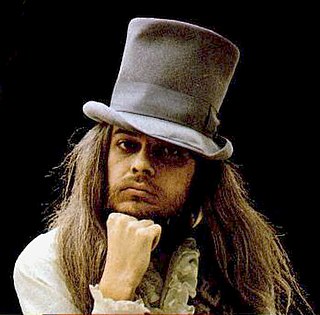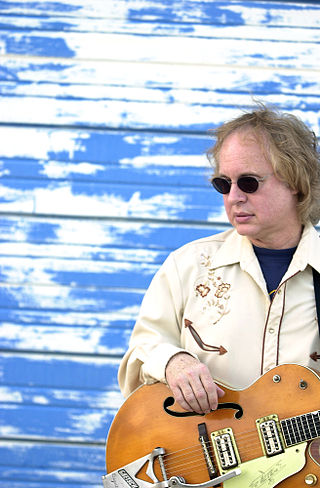Related Research Articles

John Weldon "J. J." Cale was an American guitarist, singer, and songwriter. Though he avoided the limelight, his influence as a musical artist has been acknowledged by figures such as Neil Young, Mark Knopfler, Waylon Jennings, and Eric Clapton, who described him as one of the most important artists in rock history. He is one of the originators of the Tulsa sound, a loose genre drawing on blues, rockabilly, country, and jazz.

Leon Russell was an American musician and songwriter who was involved with numerous bestselling records during his 60-year career that spanned multiple genres, including rock and roll, country, gospel, bluegrass, rhythm and blues, southern rock, blues rock, folk, surf and the Tulsa sound. His recordings earned six gold records and he received two Grammy Awards from seven nominations. In 2011, he was inducted into both the Rock and Roll Hall of Fame and the Songwriters Hall of Fame.
While the music of Oklahoma is relatively young, Oklahoma has been a state for just over 100 years, and it has a rich history and many fine and influential musicians.
Don Roscoe Joseph III, professionally known as Rocky Frisco and Rocky Curtiss, was an American musician. He was best known as the longtime pianist for J. J. Cale, and for his role in the development of the music style known as the Tulsa Sound.

Jesse Edwin Davis III was a Native American guitarist. He was well regarded as a session artist and solo performer, was a member of Taj Mahal's backing band and played with musicians such as Eric Clapton, John Lennon, and George Harrison. In 2018, he was posthumously inducted into the Native American Music Hall of Fame at the 18th Annual Native American Music Awards. Davis was an enrolled citizen of the Kiowa Indian Tribe of Oklahoma with Comanche, Muscogee, and Seminole ancestry.

Paul Steven Ripley was an American recording artist, record producer, songwriter, studio engineer, guitarist, and inventor. He entered the music industry in 1977. He was also the leader/producer of country rock band The Tractors.

Carl Dean Radle was an American bassist who toured and recorded with many of the most influential recording artists of the late 1960s and 1970s. He was posthumously inducted to the Oklahoma Music Hall of Fame in 2006.

Eric Clapton is the debut solo studio album by English rock musician Eric Clapton, released in August 1970 by Atco and Polydor Records.
Red dirt is a genre of country music that gets its name from the color of soil found in Oklahoma. Many red dirt acts got their start in bars surrounding Oklahoma State University in Stillwater, a city considered to be the center of red dirt music. The genre also extends to music made south of the Red River in Texas. Outlaw country legends Waylon Jennings and Willie Nelson have been associated with the distinctive Texas sound, while the late Oklahoma singer-songwriter Bob Childers is widely recognized as the Father of Oklahoma red dirt music. At one time, the distinction between the two genres was sonically obvious, but by 2008, that gap had diminished.

Naturally is the debut studio album by J. J. Cale released on October 25, 1971.

"After Midnight" is a rock song by J. J. Cale, first released in 1966. Eric Clapton later covered it for his eponymous album, released in 1970. Clapton's rendition became a success, prompting Cale to re-record the song for his own 1971 album Naturally. In 1987, Clapton later re-recorded the song for a Michelob beer commercial and then released the re-recording as a single. "After Midnight" has been considered one of Clapton's signature songs throughout his career. Other artists covered the song in later years.

5 is the fifth studio album by J. J. Cale. Released in 1979, it was his first album in three years. When the album was re-issued on CD, "Katy Kool Lady" was replaced by a new song listed as "Out of Style," though it was still listed as the former on the CD. "Out of Style" is also included on the 2007 album Rewind: The Unreleased Recordings under its proper title. There is still no U.S. domestic release of the song "Katy Kool Lady" on CD.

Willis Alan Ramsey is the sole studio release by the Texas songwriter Willis Alan Ramsey. The album's genre is hard to categorize with touches of country, country rock, folk, and folk rock. The tunes range from the reflection and regret of "The Ballad of Spider John" to a heartfelt tribute to Woody Guthrie on "Boy from Oklahoma". It was recorded on Leon Russell's Shelter label in 1972, and Russell sat in on piano, keyboards, and vibraphone. Other guest musicians include: Carl Radle, Jim Keltner, Red Rhodes, Leland Sklar, and Russ Kunkel. The song "Muskrat Candlelight" was covered by the band America in 1973 and by Captain & Tennille in 1976, both using the title "Muskrat Love." "The Ballad of Spider John" was covered by Jimmy Buffett on his 1974 album Living & Dying in 3/4 Time. The song "Satin Sheets" was covered by The Bellamy Brothers and Shawn Colvin. The album was mixed by Al Schmitt.

James Oldaker was an American rock music, blues rock and country music drummer and percussionist.

Delaine Alvin "Delaney" Bramlett was an American singer and guitarist. He was best known for his musical partnership with his wife Bonnie Bramlett in the band Delaney & Bonnie and Friends, which included a wide variety of other musicians, many of whom were successful in other contexts.

The Church Studio is a recording studio in Tulsa, Oklahoma established in 1972 by musician, songwriter, and producer Leon Russell. Located in a converted church building, the studio has since been cited as being the heart of the Tulsa Sound.
Brandon Dean Jenkins was an American singer-songwriter and philanthropist. He was part of the Red Dirt music genre.

Stop All That Jazz is an album by singer and songwriter Leon Russell. The album was recorded in 1974 at Russell's House Studio in Tulsa, Oklahoma; Paradise Studios in Tia Juana, Oklahoma; Pete's Place in Nashville, Tennessee; and Shelter The Church Studio, in Tulsa. Stop All That Jazz is Russell's sixth solo album.
James Keys Markham was an American harmonica player and singer. Inducted into both the Oklahoma Blues Hall of Fame and the Oklahoma Jazz Hall of Fame, he is considered a pioneer of the "Tulsa sound".
References
- ↑ Wooley, John."You know it when you hear it: Put that dictionary down: The Tulsa Sound is hard to define but easy on the ears," Tulsa World , January 2, 2004; no longer online, archived page at web.archive.org retrieved March 2, 2020.
- ↑ Hoekstra, Dave (15 April 1990). "Songwriter J. J. Cale prefers to remain in the background". Chicago Sun-Times . Archived from the original on 3 June 2013.
- ↑ Leon Russell Retrieved 21 November 2022
- ↑ Roger Tillison Retrieved 24 November 2022
- ↑ Elvin Bishop Retrieved 19 November 2022
- ↑ Singer Gus Hardin Killed in Accident. TulsaWorld.com (February 18, 1996). Retrieved on November 29, 2019.
- ↑ "Jeff Carson Biography". Oldies.com. Retrieved November 29, 2019.
- ↑ "The Tulsa Sound". The Tulsa Sound.
- ↑ "JJ Cale – Pioneer of The Tulsa Sound – Joe Bonamassa".
- ↑ Jones, Preston (April 20, 2023). "Mad Songs & Oklahomans: The Tulsa Sound Part One". Oklahoma Today.
- ↑ "Home". rockyfrisco.com.
- ↑ "CLYDE STACY". www.rockabilly.nl. Archived from the original on 2011-10-07.
- ↑ Rockabillyhall.com (accessed October 8, 2013)
- ↑ the Tri-Lads Retrieved 19 November 2022
- ↑ Flash Terry Retrieved 19 November 2022
- ↑ L Russel Retrieved 19 November 2022
- ↑ Joshua Kline, "Past and Future Sound", This Land Press, June 23, 2010.
- ↑ Mike Easterling, "Feels Like Religion: Jesus and Leon might have left the building, but almost 30 years later, the Church Studio resurrects its legendary music and religious past." Urban Tulsa Weekly , November 11, 2009.
- ↑ "With new owners, the Church Studio aims for recognition".
- ↑ Jerry Wofford, "With new owners, The Church Studio aims for recognition", Tulsa World , October 27, 2016.
- ↑ Robert Christgau, Rock Albums of the '70s: A Critical Guide (Da Capo Press, 1990), ISBN 978-0-306-80409-0, p. 82. Excerpt available at Google Books.
- ↑ John Wooley, From the Blue Devils to Red Dirt: The Colors of Oklahoma Music (Hawk Publishing Group, 2006), ISBN 978-1-930709-61-4.
- ↑ Thomas Conner, "Getting Along: Woody Guthrie and Oklahoma's Red Dirt Musicians" in Davis D. Joyce & Fred R. Harris, eds., Alternative Oklahoma: Contrarian Views of the Sooner State (University of Oklahoma Press, 2007), ISBN 978-0-8061-3819-0, p. 92. Excerpt available at Google Books.
- ↑ http://artofthesong.org/leon-russell-interview/ [ dead link ]
- ↑ https://issuu.com/craftmagok/docs/cmok_aug_2019_digital, p. 10.